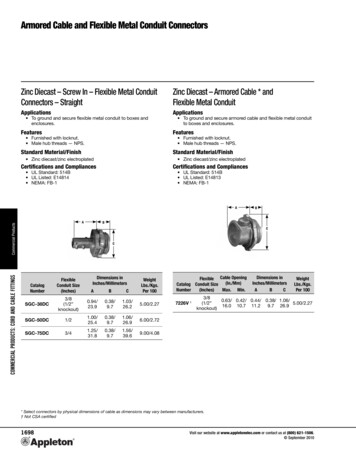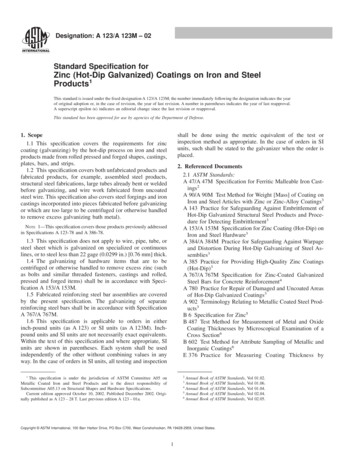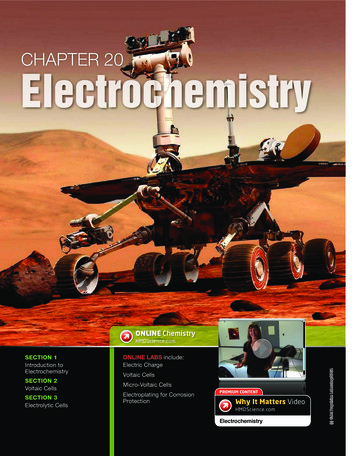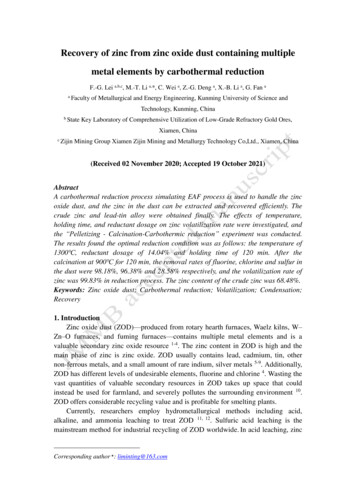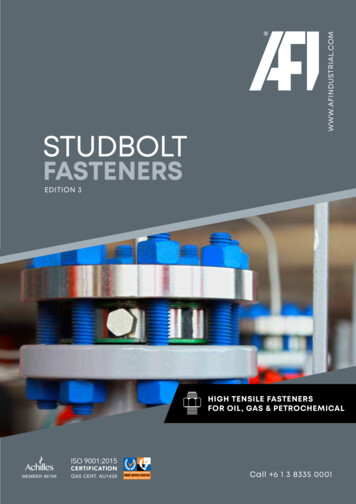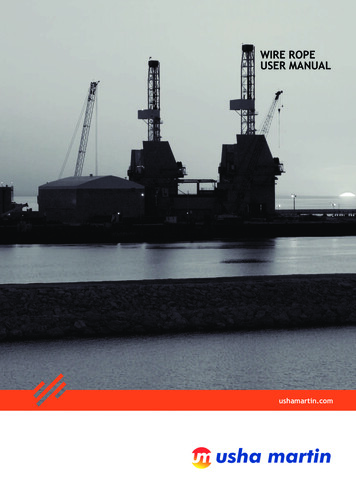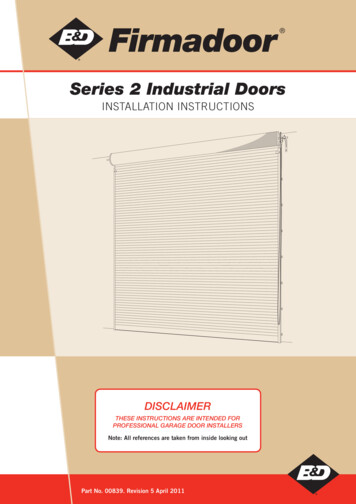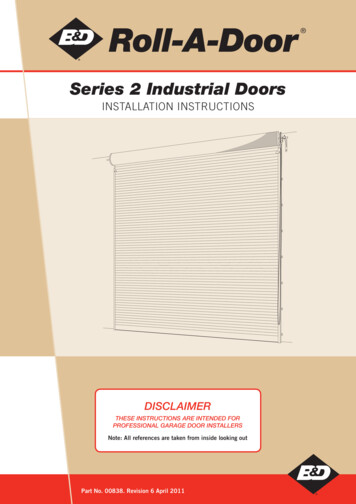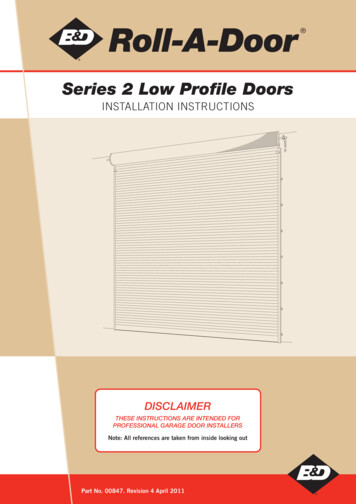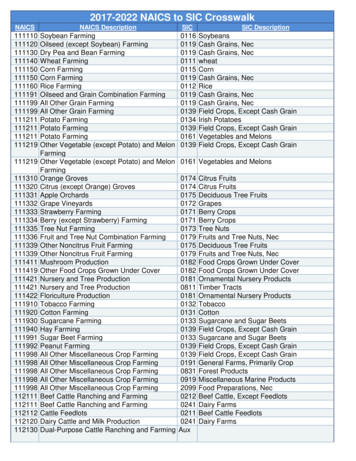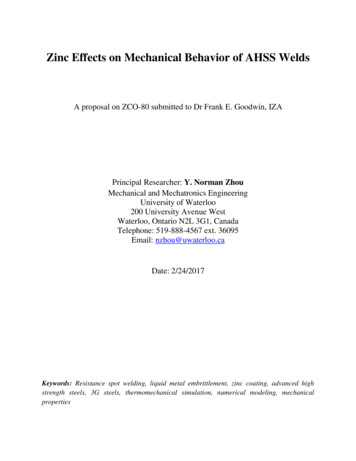
Transcription
Zinc Effects on Mechanical Behavior of AHSS WeldsA proposal on ZCO-80 submitted to Dr Frank E. Goodwin, IZAPrincipal Researcher: Y. Norman ZhouMechanical and Mechatronics EngineeringUniversity of Waterloo200 University Avenue WestWaterloo, Ontario N2L 3G1, CanadaTelephone: 519-888-4567 ext. 36095Email: nzhou@uwaterloo.caDate: 2/24/2017Keywords: Resistance spot welding, liquid metal embrittlement, zinc coating, advanced highstrength steels, 3G steels, thermomechanical simulation, numerical modeling, mechanicalproperties
Zinc Effects on Mechanical Behavior of AHSS WeldsExecutive summaryThe objective of this project is to carry out a more basic study than those have been recentlyreported to examine the fundamental mechanisms responsible for liquid metal embrittlement(LME) during resistance spot welding (RSW) and laser welding of advanced high strength steels(AHSS) including but not limited to dual phase (DP), transformation induced plasticity (TRIP)and Twinning induced plasticity (TWIP) steels. The project will identify effects of key variablessuch as base metal microstructure, coating types, weld process variables, and pre-heat and postheat treatments on the susceptibility to LME and highlight areas where it is most critical. Further,experimental and numerical simulation will be used to define stress state and temperature historiesduring welding. This study will expand the current state-of-the-art knowledge on LME and willprovide guidelines for mitigation and remediation of LME cracks during RSW and laser weldingof AHSS.Background and current statusCurrently, AHSS used in automotive structural components are commonly protected fromcorrosion by zinc (Zn) coatings. The thin layer of Zn coating is an effective means of providingcathodic protection to the underlying steel substrate. However, the steel/Zn system createspotential for LME since Zn exists in liquid phase between 419-906 C, which is well below themelting point of conventional AHSS. LME has a deleterious effect on the properties of steelbecause the onset of premature crack initiation and propagation along grain boundaries leads to asignificant reduction in strength and ductility, as illustrated in Figure 1 for electrogalvanized (EG)TWIP steel. Literature thoroughly documents the onset of LME in various steel chemistries suchas structural low carbon steel [1,2,3], tool steel [4,5] and stainless steel [6–8] but to our knowledge,little research have been published on AHSS. With automotive manufacturers turning to AHSSwith more complex microstructures, the urgency of understanding their susceptibility to LME isbecoming increasingly important.Figure 1: Tensile curves of Fe22Mn0.6C TWIP steel at 800 C for strain rate of 0.013s-1 [9].2 of 12
During body-in-white (BIW) assembly, structural components are commonly joined using RSW.RSW requires intimate contact between the sheet-sheet (S-S) interface in order to achieve a soundjoint. As a result, the clamping forces exerted on the sheets by two water-cooled electrodes inducean axial compressive strain field normal to the sheet plane [10]. Once the sheets have beensufficiently clamped, current is passed through the electrodes, fusing the sheets together throughjoule heating. At the faying surface between the two sheets, the temperature exceeds the meltingpoint of steel [11] and therefore, Zn with much lower melting point than steel will squeezed out tothe nugget periphery by the electrode force. At the electrode-sheet (E-S) contact surfaces, thegenerated heat may also be sufficient to melt the coating and cause it to flow. This melted Zncoating will lead to potential LME cracks formation under the applied electrode force and stressesgenerated during heating and cooling stage.As reported in project ZCO-73, fiber laser welding (FLW) is a high efficiency and low costtechnique to manufacture tailor welded blanks (TWBs) in the automotive industry. Furthermore,TWBs use a butt weld configuration to eliminate the issues involved in forming and die design.Generally, TWBs are made with mild or interstitial free steels; however, in recent years the weightreduction ability of TWBs have been increased by employing high strength steels like HSLA steeland advanced high strength steel (AHSS) such as different grades of DP steel, which also improvesthe crash performance of the blanks [12,13]. The temperature during laser welding of courseexceeds melting point of steel [14], hence Zn coating will melt prior to the steel, and solidify afterthe steel, which may lead to LME of the welds. Given the quantity and frequency of spot weldingin BIW assembly and laser welding in TWBs, understanding the susceptibility of AHSS to LMEhas become increasingly important since new combinations of steels and zinc coatings are beingutilized in the industry.Phenomenological studies on the mechanisms of LME have been extensively surveyed inliteratures [15–18]. Fernandes et al. [19] classified the solid metal embrittlement by liquid metalinto four distinct groups: (i) instantaneous failure of the solid substrate under applied stress orresidual stress when in contact with the liquid metal, (ii) delayed failure of a solid metal in contactwith a liquid metal under static stress below the tensile strength of the metal, (iii) stressindependent grain boundary penetration of a liquid metal in solid and (iv) high temperaturecorrosion. Delayed failure under stress and stress-independent grain boundary penetration (groupsii. and iii.) will the focused of this research, because of their observed association with the RSWprocess. The prerequisite conditions required for LME to occur have been attributed to thepresence of the following factors: direct contact between liquid metal and the solid substrate andpresence of an applied (or residual) stress within the substrate material [1]. The mechanisms ofLME were extensively studied during the 1960s but have once again been brought to the forefrontdue to processing applications which result in conditions conducive to LME. The literature outlinessix models for LME crack propagation which have been reduced to four classes by Joseph et al.as follows [20]: dissolution-diffusion [21,22], brittle fracture theory [17,23,24], ductile tip tearing3 of 12
[25–31], and liquid-grain boundary penetration [32,33]. Moreover, Nichols and Rostoker [34]indicated that LME crack initiation was resulted from the interfacial interaction betweendislocation pile-ups and the solid-liquid interface. It was suggested that liquid metal wetting alongthe grain boundaries was the preferred surface energy reduction mode, thus driving crackpropagation into the solid substrate. Also, Stoloff and Johnston [17] proposed that the liquid metalserves to decrease the binding energy of the atomic bonds at the crack tip, thus contributing toLME crack propagation. Westwood and Kamdar [23] suggested that the penetration of the liquidmetal to the crack tip was sufficient to strain the atomic bonds of the solid metal enough to resultin chemisorption, thus breaking the substrate atomic bonds and inducing sufficient strain to thesystem to repeat the process. Perrone and Liebowitz [35] suggested that capillary action assistedby a tensile field at the crack root contributes to further propagation into the substrate. Morerecently, Cho et al. [36] suggested that LME cracks are easily initiated at α-Fe(Zn) grainboundaries in the interfacial alloy. A schematic of the different models are presented in Figure 2below. It has been widely accepted in most models, that the liquid-solid interfacial energy andgrain boundary energy have a significant effect on LME in steels [20].Figure 2: Schematic diagram of phenomenological models of LME [20]Reports on sensitivity of AHSS to LME during RSW are scarce in the literature. Sigler et al. [37]reported on the first studies of LME during resistance spot welding of HDG Dual Phase (DP) andTransformation Induced Plasticity (TRIP) steel. LME has been found to occur as surface cracks inthe spot welds of both DP and TRIP steels [38–40]. It has been observed by Sigler et al. [37] thatsusceptibility to LME increased when austenitic microstructures were present. However, theeffects of different microstructure attributes such as amount of austenite, austenite grain size anddistribution, presence of alloying elements and the type of coating have been poorly documentedand may have a significant effect on LME cracking susceptibility. Tolf et al. [40] observed that4 of 12
surface cracking phenomenon was more pronounced in galvanized (GI) coatings compared to EGcoatings and theorized that the aluminum in the GI inhibition layer preferentially acts as insulatorto resistively increase the joule heating at the electrode-steel (E-S) interface. Kim et al. [41]performed surface crack evaluations on spot welds of TRIP steels and observed that the occurrenceof cracking increased with high current, long weld time and short hold times. It was also suggestedthat different electrode shapes had an effect on the location at which surface cracks initiated [41].Zn-Cu intermetallic phases were identified at the LME crack tips suggesting that alloying with thecopper electrode had also occurred. It should be noted that liquid copper has also been reported toinduce LME in steels [42].Furthermore, investigations on the susceptibility of high Mn TWIP steel was carried out by Bealet al. [9,10,43]. Through thermomechanical simulations, it was determined that quasi-static tensilestrain rates above 0.0013s-1 had a significant effect on the embrittlement threshold in EG TWIPsteel [9]. The reduction in flow stress at high isothermal hold temperatures (750-900 C) increasesthe susceptibility of the substrate to LME crack initiation resulting in a significant reduction inductility as demonstrated in Figure 3. Therefore, cracking was only found to occur in the presenceof liquid zinc when a threshold temperature, strain rate and stress were achieved [10]. Sorpas andSysweld were used to simulate the weld cycles and confirm the temperature and strain rates presentat the E-S interface. According to the author, the stresses at the E-S interface are compressive inthe optimal weld parameter window and no studies on LME have been performed undercompressive stress [10]. However, under non-optimal conditions where expulsion and LME havebeen identified, simulations of the strain fields were unable to resolve the dynamic events.Therefore, it remains to be clarified the precise conditions at which LME is expected to occur.Furthermore, microstructure evolution was not considered in the models and would inevitablycontribute significantly to the occurrence of LME.Figure 3: Ductility trough of Fe22Mn0.6C steel in the presence of liquid zinc fordifferent strain rates as a function of isothermal temperature [43]Literature has also found that IMC formation is a competing process by which the volumetricreduction of zinc is capable of inhibiting embrittlement [43], and several suggested process5 of 12
solutions to avoid LME cracking include optimizing the welding parameters such as currentsloping to reduce stresses, adding a pre-pulse and increasing the holding time [10,41].There are very few studies on LME formation during laser welding. It was reported during CO2laser lap joints of austenitic stainless steel, LME cracks occurred above 750 C when it is exposedto molten zinc and tensile stresses [44]. The tensile stress could be generated via heating andcooling cycle during welding. Hiraishi et al. [45] also reported formation of LME cracks duringlaser lap welding of stainless steel to Cu-Zn alloy (brass).Based on the literature survey, the major uncertainties that need to be resolved with regards toLME during RSW and laser welding of AHSS are as follows:1. Microstructural influences and phase transformation of base metal on the susceptibility ofLME. Literature suggests that austenitic microstructures are more susceptible to LME thanother microstructures; therefore, it is important to study the effects of content of retainedaustenite in base metal. Furthermore, effects of other microstructural details, such asaustenite grain size and distribution in the steel, different alloying elements needs to beexplored.2. The nature of the stress field detrimental to the formation of LME cracks during RSW andlaser welding. During RSW, the temperature gradient between the HAZ and E/S interfaceresults in differential thermal expansion which creates residual stresses of tension andcompression during, and after the process. Similarly, stresses are developed via heatingand cooling cycle during laser welding. An understanding of the nature, magnitude anddistribution of these stresses is necessary for prediction of the possibility and location ofLME cracks within the RSW and laser welded joints.3. The influence of different weld parameters on the onset of LME behavior and the limits towhich they produce deleterious effects. As mentioned earlier, different weld parametersappear to influence the onset of LME during welding. However, the amount of informationand the extent to which certain parameters are concern has not been statistically confirmed.4. The severity of LME to the mechanical performance of the weld. Of the limited studies onLME in literature, only the effects on fatigue have been studied in depth. Although theauthors found that LME surface cracks in the spot weld have little effect on the fatigueperformance, the performance can be significantly affected by the severity of theembrittlement. With increasing crack depth, the mechanical integrity of the weld maybecome compromised.ObjectivesThe project will aim to satisfy the following objectives:1. Simulate the stress-strain cycles associated with RSW and laser welding of AHSS to furtherdefine the conditions where LME is most problematic.6 of 12
2. Develop understanding of the susceptibility of AHSS to LME through thermomechanicaltesting of various zinc coating compositions.3. Evaluate the effect of various microstructural attributes such as content of retainedaustenite, grain size, grain distribution, and alloying elements on susceptibility to LME.4. Investigate in detail the contribution thresholds of different welding parameters required toinduce LME cracking in AHSS during the RSW and laser welding.5. Experimentally quantify and validate numerical models of the stress fields present duringthe RSW and laser welding.6. Correlate the mechanical properties to the onset of LME in AHSS welds with respect totensile and fatigue properties at room temperature.7. Develop guidelines for the mitigation and remediation of LME cracks in AHSS duringRSW and laser welding.Research MethodologyA flowchart representing the research methodology that will be employed to achieve the objectivesis outlined below in Figure 4.Figure 4: A representation of the overall experimental methodology of the proposed work.Task 1 –LME Susceptibility Characterization and Thermomechanical simulationInitially, a series of experiments will be performed on various available AHSS such as DP steel,TRIP steel, TWIP steel, 3G Med Mn steel, Usibor etc. with different galvanized conditions (e.g.,EG, GI, GA) using RSW and laser welding to establish conditions where LME is mostproblematic. The HSLA with a hot dip coating will be used as a control. Special attention will begiven to correlating the volume fraction, grain size, and grain distribution of austenite to LME7 of 12
susceptibility. LME cracks will be analyzed using optical microscopy (OM), scanning electronmicroscopy (SEM), and X-ray computer tomography (CT). In order to analyze LME susceptibilityduring laser welding of AHSS, pre-deformed specimens or externally stressed specimens in bothbutt and lap configuration will be used. Moreover, tensile coupons will be tested in a Gleeblethermomechanical simulator at various isothermal temperatures and strain rates to establish theductility trough for each combination of AHSS and zinc coatings. After testing to failure,specimens will be cross-sectioned and characterized by OM and SEM. Special attention will bedirected to LME crack characterization through the use of micro x-ray diffraction (XRD) andelectron back scatter detection (EBSD) to analyze grain texture.Task 2: Mechanical performance evaluation of AHSS spot weldsIn order to establish most problematic conditions for LME for various AHSS with differentgalvanized conditions, initial mechanical testing such as quasi-static uniaxial tensile testing, crosstension testing (RSW only) and fatigue testing will be performed. Tensile shear and cross tensiontesting for RSW will be conducted according to AWS D8.9 standard. Tensile testing for laser buttwelds will be performed according to ASTM E8. Fatigue testing will also be performed accordingto ASTM E8 to assess the effect LME cracks have on the fatigue life of the welds. After in-depthanalysis, optimized parameters will be used to perform systematic evaluation of mechanicalproperties to established guideline for mitigation of LME cracks during RSW and laser weldingof AHSS.Task 3: Constitutive analysis of induced strain fields during RSW and LBWLME requires stress to initiate LME crack and crack growth. Therefore, in order to reconcilestresses assessed in Task 1 with the actual stresses generated during welding, both experimentaland numerical methods must be considered. Experimental analysis will be carried out using TEMor XRD to determine the nature and distribution of residual stresses in the joint. Numericalsimulations using Sorpas and/or ABAQUS will be made to estimate the stresses to compare withthe experimental data. Also, microstructure evolution will be considered in the models whichwould inevitably contribute significantly to the occurrence of LME. Moreover, effects of differentelectrode shapes and degree of wear, electrode cooling, part gap and electrode tip angle will beanalyzed to investigate the relationship with stress field during RSW.Task 4: Weld parameter correlationSpot welding parameters to be investigated for this task will include, but are not limited, to thefollowing: clamping force, welding current, weld cycle time, holding time, multiple pulses andpulse frequency. Similarly, fiber laser welding parameters such as welding power, welding speed,etc. will be analyzed. An appropriate design of experiments (DoE) table will be developed to assess8 of 12
the effect of each parameter on the occurrence of LME for each AHSS and zinc coatingcombination. To establish a baseline for RSW, the Auto/Steel Partnership (A/SP) weldingguidelines for coated AHSS which are based on AWS D8.9 will be followed [46]. After welding,images of the surface will be documented for visual inspection and CT analysis before crosssectioning for metallography and microscopy. Welds containing LME cracks will be furtheranalyzed using the analysis methods outlined in Task 1. Several cracks will be fractured to assessthe presence of complex zinc IMC compounds on the crack surfaces to determine their importanceto the phenomenon.Work PlanThe Gantt chart displayed below outlines the expected timeline for the associated tasks anddeliverables. The principle researcher will be Dr. Zhou and he will manage all progress related tothe research.Team expertiseThe University of Waterloo will deliver talk in semi-annual North American GAP meetings, yearend reports, and a final comprehensive report for this project. Dr. Y. Norman Zhou will be principalinvestigator coordinating the overall research activities at the University of Waterloo. Dr. AndrewMacwan would participate as investigators supervising students in the project. Dr. Frank Goodwinwill monitor the project on behalf of International Zinc Association.Dr. Y. Norman Zhou is Professor and University Research Chair at the University of Waterloo.His research interests cover process development and optimization, and metallurgical studies inadvanced materials joining (including microjoining and nanojoining). Dr. Zhou is the ProjectLeader for Welding and Joining in Auto 21 program funded by Canadian National Centre of9 of 12
Excellence (NCE) on laser, resistance and friction stir welding of advanced high strength steels,aluminum and magnesium alloys. He is also the Canadian Task Leader on Welding and Joining ina US-Canada-China joint R&D project on Magnesium Front End Research and Development(MFERD). He is currently leading a group with about 20 graduate students, post-doctoral fellowsand other researchers, working on various materials joining technologies. His research is fundedby funding agencies and industrial companies from all over the world, such as Huys Industries,Dofasco, Centreline, Magna, NSERC, Auto/Steel Partnership (USA), IZA (USA), St. JudeMedical (USA), RIST (South Korea), MKE (South Korea), ESEC (Switzerland), etc.Budget (per annum in US dollars)University CostsOne Masters studentPart-time post-doctoral fellowParts and componentsUser fee of analytical instruments (XRD, SEM/EDS, etc)Publication costSubtotalOverhead (30% of subtotal)Total University CostFunding requested from IZAFunding from Canadian and Ontario Funding AgenciesIn-kind contribution (user fee of RSW and FLW)Year 1 20,000 20,000 5,000 8,000 2,000 55,000 16,500 71,500 45,000 26,500 10,000Year 2 20,000 20,000 5,000 8,000 2,000 55,000 16,500 71,500 45,000 26,500 10,000Year 3 20,000 20,000 5,000 8,000 2,000 55,000 16,500 71,500 45,000 26,500 10,000References[1][2][3][4][5][6][7][8]M.G.G. Nicholas, C.F.F. Old, M.D. Division, Review - Liquid metal embrittlement, J.Mater. Sci. 14 (1979) 1–18. doi:10.1007/BF01028323.J. Carpio, J.A. Casado, J.A. Álvarez, D. Méndez, F. Gutiérrez-Solana, Stress corrosioncracking of structural steels immersed in hot-dip galvanizing baths, Eng. Fail. Anal. 17(2010) 19–27. doi:10.1016/j.engfailanal.2008.11.005.W.J. Rudd, S.W. Wen, P. Langenberg, B. Donnay, A. Voelling, T. Pinger, M. Feldmann,J. Carpio, S. a. Casado, J. a. Alvarez, F. Gutiérrez-Solana, Failure mechanisms duringgalvanising, 2008.K. Nakasa, M. Suzawa, Crack propagation and crack branching of high strength steels inliquid zinc embrittlement., J. Soc. Mater. Sci. Japan. 37 (1988) 676–682.doi:10.2472/jsms.37.676.M. Vermeersch, W. De Waele, N. Van Caenegem, LME susceptibility of galvanisedwelded structures of high strength steels, Sustain. Constr. Des. 2011. 2 (2011) 442–447.C.P. Dillon, Liquid metal cracking of stainless steels in chemical plants, Mater. Perform.29 (1990) 54–55.R.M. Bruscato, Liquid Metal Embrittlement of Austenitic Stainless Steel When Welded toGalvanized Steel, Weld. J. (1992) 455–460.H. Mori, K. Nishimoto, Effect of Chromium and Nickel Contents on Liquid Zinc10 of 12
][22][23][24][25][26][27][28][29]Embrittlement in Heat Affected Zone of Austenitic Steels, Q. J. Japan Weld. Soc. 30(2012) 42–49. doi:10.2207/qjjws.30.42.C. Beal, X. Kleber, D. Fabregue, M. Bouzekri, Embrittlement of a zinc coated highmanganese TWIP steel, Mater. Sci. Eng. A. 543 (2012) 76–83.doi:10.1016/j.msea.2012.02.049.C. Beal, Mechanical behaviour of a new automotive high manganese TWIP steel in thepresence of liquid zinc, (2011).H. Zhang, J. Senkara, Resistance welding : fundamentals and applications, 2012.M. Uchihara, K. Fukui, Formability of tailor welded blanks fabricated by differentwelding processes. Study of tailor welded blanks using automotive high-strength steelsheets (1st report), Weld. Int. 20 (2006) 612–621. doi:10.1533/wint.2006.3628.H. Kusuda, T. Takasago, F. Natsumi, Formability of tailored blanks, J. Mater. Process.Technol. 71 (1997) 134–140. 3.N. Lun, Laser Welding of Medium-Manganese Steel, University of Waterloo, 2016.V.W. Eldred, Interactions between solid and liquid metals and alloys, AERE X/F (1955).W. Rostoker, J.M. McCaughey, H. Markus, Embrittlement of liquid metals, Rheinhold,New York, 1960.N.S. Stoloff, T.L. Johnston, Crack propagation in a liquid metal environment, Acta Metall.11 (1963) 251–256. doi:10.1016/0001-6160(63)90180-9.M.H. Kamdar, Embrittlement by liquid metals, Prog. Mater. Sci. 15 (1973) 289–374.doi:10.1016/0079-6425(73)90005-4.P.J.L. Fernandes, R.E. Clegg, D.R.H. Jones, Failure by liquid metal inducedembrittlement, Eng. Fail. Anal. 1 (1994) 51–63.B. Joseph, M. Picat, F. Barbier, Liquid metal embrittlement: A state-of-the-art appraisal,Eur. Phys. J. Appl. Phys. 5 (1999) 19–31. doi:10.1051/epjap:1999108.W.M. Robertson, Propagation of a crack filled with liquid metal, Trans. AIME. 236(1966) 1478–82.E.E. Glickman, Y.V. Goryunov, Mechanism of embrittlement by liquid metals and othermanifestations of the rebinder effects in metal systems, Sov. Mater. Sci. 4 (1977) 355–364.A.R.C. Westwood, M.H. Kamdar, Concerning liquid metal embrittlement, particularly ofzinc monocrystals by mercury, Philos. Mag. 8 (1963) 787–804.doi:10.1080/14786436308213836.M.J. Kelley, N.S. Stoloff, Analysis of liquid metal embrittlement from a bond energyviewpoint, Metall. Trans. A. 6 (1975) 159–166. doi:10.1007/BF02673684.I.G. Dmukhovskaya, V.V. Popovich, Influence of the adsorption of working media ondeformation of solids, Sov. Mater. Sci. 12 (1976) 394–399.V.V. Popovich, I.G. Dumukhovskaya, Rebinder effect in the fracture of Armco iron inliquid metals, Sov. Mater. Sci.1. 14 (1978) 365–370.I.G. Dumukhovskaya, V.V. Popovich, A phenomenological model of embrittlement ofmetals under conditions of the adsorption of action of liquid metal media, Sov. Mater. Sci.18 (1982) 461–467.V.V. Popovich, I.G. Dumukhovskaya, The embrittlement of metals and alloy beingdeformed in contact with low melting alloys, Sov. Mater. Sci. 23 (1987) 535–544.S.P. Lynch, Environmentally assisted cracking: Overview of evidence for an adsorptioninduced localised-slip process, Acta Metall. 36 (1988) 2639–2661. doi:10.1016/0001-11 of 12
2][43][44][45][46]6160(88)90113-7.S.P. Lynch, Metallographic contributions to understanding mechanisms ofenvironmentally assisted cracking, Metallography. 23 (1989) 147–171. doi:10.1016/00260800(89)90016-5.S.P. Lynch, Metal-induced embrittlement of materials, Mater. Charact. 28 (1992) 279–289. doi:10.1016/1044-5803(92)90017-C.P. Gordon, Metal-Induced embrittlement of metals-an evaluation of embrittler transportmechanisms, Metall. Trans. A. 9 (1978) 267–273. doi:10.1007/BF02646710.P. Gordon, H.H. An, The mechanisms of crack initiation and crack propagation in metalinduced embrittlement of metals, Metall. Trans. A. 13 (1982) 457–472.doi:10.1007/BF02643354.H. Nichols, W. Rostoker, On the mechanism of crack initiation in embrittlement by liquidmetals, Acta Metall. 9 (1961) 504–509.N. Perrone, H. Liebowitz, Effect of capillary action on fracture due to liquid metalembrittlement, (1967).L. Cho, H. Kang, C. Lee, B.C. De Cooman, Microstructure of liquid metal embrittlementcracks on Zn-coated 22MnB5 press-hardened steel, Scr. Mater. 90–91 (2014) 25–28.doi:10.1016/j.scriptamat.2014.07.008.D.R. Sigler, J.G. Schroth, W. Yang, X.Q. Gayden, C. Jiang, Y. Sang, P.J. Morin,Observations of Liquid Metal-Assisted Cracking in Resistance Spot Welds of Zinc-CoatedAdvanced High-Strength Steels, in: Sheet Met. Weld. Conf. XIII, 2008.H. Gaul, G. Weber, M. Rethmeier, Influence of HAZ cracks on fatigue resistance ofresistance spot welded joints made of advanced high strength steels, Sci. Technol. Weld.Join. 16 (2011) 440–445. doi:10.1179/1362171810Y.0000000031.C. Ma, D.L. Chen, S.D. Bhole, G. Boudreau, a. Lee, E. Biro, Microstructure and fracturecharacteristics of spot-welded DP600 steel, Mater. Sci. Eng. A. 485 (2008) 334–346.doi:10.1016/j.msea.2007.08.010.E. Tolf, J. Hedegård, a Melander, Surface breaking cracks in resistance spot welds of dualphase steels with electrogalvanised and hot dip zinc coating, Sci. Technol. Weld. Join. 18(2013) 25–31. doi:10.1179/1362171812Y.0000000068.Y.G. Kim, I.J. Kim, J.S. Kim, Y. Il Chung, D.Y. Choi, Evaluation of Surface Crack inResistance Spot Welds of Zn-Coated Steel, 55 (2014) 171–175.A.G. Glover, D. Hauser, E.A. Metzbower, Embrittlement of Stainless Steel by LiquidCopper From a Welding Fixture, in: Fail. Anal. Prev., 1986: pp. 411–449.C. Beal, X. Kleber, D. Fabregue, M. Bouzekri, Liquid zinc embrittlement of twinninginduced plasticity steel, Scr. Mater. 66 (2012) .-M. El-Batahgy, Laser Beam Welding of Austenitic Stainless Steels–Similar Butt andDissimilar Lap Joints, in: Weld. Process., 2012: pp. 93–116.doi:http://dx.doi.org/10.5722/48756.M. HIRAISHI, M. YOSHIDA, H. SUGAI, K. HOSHINO, T. OHIRA, Laser Lap-Weldingof Stainless Steel to Cu Alloy, Q. J. JAPAN Weld. Soc. 17 (1999) 420–425.doi:10.2207/qjjws.17.420.Autobody/Steel Partnership: AHSS Joining - Resistance Spot Weld Schedules for AHSS,(n.d.).12 of 12
generated during heating and cooling stage. As reported in project ZCO-73, fiber laser welding (FLW) is a high efficiency and low cost technique to manufacture tailor welded blanks (TWBs) in the automotive industry. Furthermore, TWBs use a butt weld configuration to eliminate the issues involved in forming and die design.
